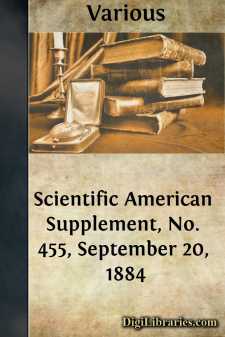Categories
- Antiques & Collectibles 13
- Architecture 36
- Art 48
- Bibles 22
- Biography & Autobiography 813
- Body, Mind & Spirit 142
- Business & Economics 28
- Children's Books 17
- Children's Fiction 14
- Computers 4
- Cooking 94
- Crafts & Hobbies 4
- Drama 346
- Education 46
- Family & Relationships 57
- Fiction 11829
- Games 19
- Gardening 17
- Health & Fitness 34
- History 1377
- House & Home 1
- Humor 147
- Juvenile Fiction 1873
- Juvenile Nonfiction 202
- Language Arts & Disciplines 88
- Law 16
- Literary Collections 686
- Literary Criticism 179
- Mathematics 13
- Medical 41
- Music 40
- Nature 179
- Non-Classifiable 1768
- Performing Arts 7
- Periodicals 1453
- Philosophy 64
- Photography 2
- Poetry 896
- Political Science 203
- Psychology 42
- Reference 154
- Religion 513
- Science 126
- Self-Help 84
- Social Science 81
- Sports & Recreation 34
- Study Aids 3
- Technology & Engineering 59
- Transportation 23
- Travel 463
- True Crime 29
Scientific American Supplement, No. 455, September 20, 1884
by: Various
Categories:
Description:
Excerpt
THE TEMPERATURE OF THE EARTH AS SHOWN BY DEEP MINES.
At a recent meeting of the American Society of Civil Engineers, observations on the temperature of the earth, as shown by deep mines, were presented by Messrs. Hamilton Smith, Jr., and Edward B Dorsey. Mr. Smith said that the temperature of the earth varies very greatly at different localities and in different geological formations. There are decided exceptions to the general law that the temperature increased with the depth. At the New Almaden quicksilver mine, in California, at a depth of about 600 feet the temperature was very high—some 115 degrees; but in the deepest part of the same mine, 1,800 feet below the surface and 500 feet below sea level, the temperature is very pleasant, probably less than 80 degrees. At the Eureka mines, in California, the air 1,200 feet below the surface appears nearly as cool as 100 feet below the surface. The normal temperature of the earth at a depth of 50 or 60 feet is probably near the mean annual temperature of the air at the particular place. At the Comstock mines, some years since, the miners could remain but a few moments at a time, on account of the heat. Ice water was given them as an experiment; it produced no ill effects, but the men worked to much better advantage; and since that time, ice water is furnished in all these mines, and drunk with apparently no bad results.
Mr. E.B. Dorsey said that the mines on the Comstock vein, Nevada, were exceptionally hot. At depths of from 1,500 to 2,000 feet, the thermometer placed in a freshly drilled hole will show 130 degrees. Very large bodies of water have run for years at 155 degrees, and smaller bodies at 170 degrees. The temperature of the air is kept down to 110 degrees by forcing in fresh air cooled over ice.
Captain Wheeler, U.S. Engineers, estimated the heat extracted annually from the Comstock by means of the water pumped out and cold air forced in, as equal to that generated by the combustion of 55,560 tons of anthracite coal or 97,700 cords of wood. Observations were then given upon temperature at every 100 feet in the Forman shaft of the Overman mine, running from 53 degrees at a depth of 100 feet to 121.2 degrees at a depth of 2,300 feet. The temperature increased:
- 100 to 1,000 feet deep, increase 1 degree in 29 feet.
- 100 to 1,800 feet deep, increase 1 degree in 30.5 feet.
- 100 to 2,300 feet deep, increase 1 degree in 32.3 feet.
A table was presented giving the temperatures of a large number of deep mines, tunnels, and artesian wells. The two coolest mines or tunnels are in limestone, namely, Chanarcillo mines and Mont Cenis tunnel; and the two hottest are in trachyte and the "coal measures," namely, the Comstock mines in trachyte and the South Balgray in the "coal measures." Mr. Dorsey considered that experience showed that limestone was the coolest formation.
C. Schmitt and A. Coblenzl have made a careful investigation of the unfermentable substances found in commercial starch sugars, and have succeeded in isolating a definite compound, to which they give the name gallisin....












